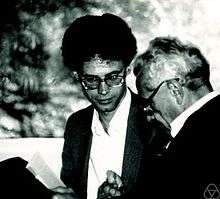Roger Heath-Brown
| Roger Heath-Brown | |
|---|---|
 Heath-Brown in 1986 | |
| Born | 12 October 1952 |
| Residence | United Kingdom |
| Citizenship | United Kingdom |
| Fields | Pure mathematics |
| Institutions | University of Oxford |
| Alma mater | University of Cambridge |
| Thesis | Topics in Analytic Number Theory (1979) |
| Doctoral advisor | Alan Baker |
| Known for | Analytic number theory |
| Notable awards |
Smith's Prize (1976) Berwick Prize (1981) Fellow of the Royal Society (1993) Senior Berwick Prize (1996) Pólya Prize (2009) |
David Rodney "Roger" Heath-Brown F.R.S. (born 12 October 1952),[1] is a British mathematician working in the field of analytic number theory.
Life
He was an undergraduate and graduate student of Trinity College, Cambridge; his research supervisor was Alan Baker. In 1979 he moved to the University of Oxford, where since 1999 he has held a professorship in pure mathematics.[1]
Heath-Brown is known for many striking results. He proved that there are infinitely many prime numbers of the form x3 + 2y3.[2] In collaboration with S. J. Patterson in 1978 he proved the Kummer conjecture on cubic Gauss sums in its equidistribution form. He has applied Burgess's method on character sums to the ranks of elliptic curves in families. He proved that every non-singular cubic form over the rational numbers in at least ten variables represents 0.[3] Heath-Brown also showed that Linnik's constant is less than or equal to 5.5.[4] More recently, Heath-Brown is known for his pioneering work on the so-called determinant method. Using this method he was able to prove a conjecture of Serre in the four variable case in 2002.[5] This particular conjecture of Serre was later dubbed the ``dimension growth conjecture" and this was almost completely solved by various works of Browning, Heath-Brown, and Salberger by 2009. [6]
Awards and honours
The London Mathematical Society has awarded Heath-Brown the Junior Berwick Prize (1981), the Senior Berwick Prize (1996),[7] and the Pólya Prize (2009). He was made a Fellow of the Royal Society in 1993,[1] and a corresponding member of the Göttingen Academy of Sciences in 1999.[8]
He was an invited speaker in International Congress of Mathematicians 2010, Hyderabad on the topic of "Number Theory."[9]
In 2012 he became a fellow of the American Mathematical Society.[10]
See also
References
- 1 2 3 "Prof Roger Heath-Brown, FRS". Debrett's People of Today. Retrieved 28 December 2010.
- ↑ Heath-Brown, D.R. (2001). "Primes represented by x3 + 2y3". Acta Mathematica. 186: 1–84. doi:10.1007/BF02392715.
- ↑ D. R. Heath-Brown, Cubic forms in ten variables, Proceedings of the London Mathematical Society, 47(3), pages 225–257 (1983) doi:10.1112/plms/s3-47.2.225
- ↑ D. R. Heath-Brown, Zero-free regions for Dirichlet L-functions, and the least prime in an arithmetic progression, Proceedings of the London Mathematical Society, 64(3), pages 265–338 (1992) doi:10.1112/plms/s3-64.2.265
- ↑ D.R. Heath-Brown, The density of rational points on curves and surfaces, Annals of Mathematics, 155(2), pages 553-598 (2002)
- ↑ T. D. Browning, Quantitative Arithmetic of Projective Varieties, Progress in Mathematics, 277, Birkhauser
- ↑ Berwick prizes page at The MacTutor History of Mathematics archive
- ↑ "Professor Roger Heath-Brown". The Mathematical Institute, University of Oxford. Retrieved 28 December 2010.
- ↑ "ICM Plenary and Invited Speakers since 1897". International Congress of Mathematicians.
- ↑ List of Fellows of the American Mathematical Society, retrieved 2013-01-19.